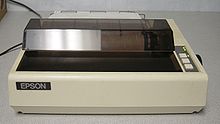Albert Usama Reigns
Sir Omar
VIII Green
14
Dot Matrix Printers
Dot matrix printing or impact matrix printing is a type of computer printing which uses a print head that moves back-and-forth, or in an up-and-down motion, on the page and prints by impact, striking an ink-soaked cloth ribbon against the paper, much like the print mechanism on a typewriter. However, unlike a typewriter or daisy wheel printer, letters are drawn out of adot matrix, and thus, varied fonts and arbitrary graphics can be produced.
The first dot matrix printer was introduced by the Japanese manufacturer OKI as OKI Wiredot in 1968. For this achievement, OKI received an award from the Information Processing Society of Japan (IPSJ) in 2013.
The DEC LA30 was a 30 character/second dot matrix printer introduced in 1970 by Digital Equipment Corporation of Maynard, Massachusetts. It printed 80 columns of uppercase-only 5×7 dot matrix characters across a unique-sized paper. The printhead was driven by a stepper motor and the paper was advanced by a somewhat-unreliable and definitely noisy solenoid ratchet drive. The LA30 was available with both a parallel interface and a serial interface; however, the serial LA30 required the use of fill characters during the carriage-return
The LA30 was followed in 1974 by the LA36, which achieved far greater commercial success, becoming for a time the standard dot matrix computer terminal. The LA36 used the same print head as the LA30 but could print on forms of any width up to 132 columns of mixed-case output on standard green bar fanfold paper. The carriage was moved by a much-more-capable servo drive using a DC electric motor and an optical encoder / tachometer. The paper was moved by a stepper motor. The LA36 was only available with a serial interface but unlike the earlier LA30, no fill characters were required. This was possible because, while the printer never communicated at faster than 30 characters per second, the mechanism was actually capable of printing at 60 characters per second. During the carriage return period, characters werebuffered for subsequent printing at full speed during a catch-up period. The two-tone buzz produced by 60 character-per-second catch-up printing followed by 30 character-per-second ordinary printing was a distinctive feature of the LA36 quickly copied by many other manufacturers well into the 1990s. Most efficient dot matrix printers used this buffering technique.
Digital then broadened the basic LA36 line onto a wide variety of dot matrix printers including:
- LA180: 180 c/s line printer
- LS120: 120 c/s terminal
- LA120: 180 c/s advanced terminal
- LA34: Cost-reduced terminal
- LA38: An LA34 with more features
- LA12: A portable terminal
In 1970, Centronics (then of Hudson, New Hampshire) introduced a dot matrix printer, the Centronics 101. The search for a reliable printer mechanism led it to develop a relationship with Brother Industries, Ltd of Japan, and the sale of Centronics-badged Brother printer mechanisms equipped with a Centronics print head and Centronics electronics. Unlike Digital, Centronics concentrated on the low-end line printer marketplace with their distinctive units. In the process, they designed theparallel electrical interface that was to become standard on most printers until it began to be replaced by the Universal Serial Bus (USB) in the late 1990s.
ot matrix printers, like any impact printer, can print on multi-part stationery or make carbon-copies. Impact printers have one of the lowest printing costs per page. As the ink is running out, the printout gradually fades rather than suddenly stopping partway through a job. They are able to use continuous paper rather than requiring individual sheets, making them useful for data logging. They are good, reliable workhorses ideal for use in situations where low printing cost is more important than quality. The ink ribbon also does not easily dry out, including both the ribbon stored in the casing as well as the portion that is stretched in front of the print head; this unique property allows the dot-matrix printer to be used in environments where printer duty can be rare, for instance, as with a Fire Alarm Control Panel's output.
Impact printers create noise when the pins or typeface strike the ribbon to the paper.[6] Sound-damping enclosures may have to be used in quiet environments. They can only print lower-resolution graphics, with limited color performance, limited quality, and lower speeds compared to non-impact printers. While they support fanfold paper with tractor holes well, single-sheet paper may have to be wound in and aligned by hand, which is relatively time-consuming, or a sheet feeder may be utilized which can have a lower paper feed reliability. When printing labels on release paper, they are prone to paper jams when a print wire snags the leading edge of the label while printing at its very edge. For text-only labels (e.g., mailing labels), a daisy wheel printer or band printer may offer better print quality and a lower risk of damaging the paper.
The advantages are: low purchase cost, can handle multipart forms, cheap to operate, only needs fresh ribbons, rugged, low repair cost and the ability to print on continuous paper. This makes it possible to print long banners that span across several sheets of paper.
The disadvantages are: noisy, low resolution (you can see the dots making up each character), not all can do color, color looks faded and streaky, slowness and more prone to jamming - with jams that are more difficult to clear. This is because paper is fed in using two sprockets engaging with holes in the paper. A small tear on the side of a sheet can cause a jam, with paper debris that is tedious to remove.











Your Comment Will Be Answered In 24 Hours Inshallah And I Will Try To Do Everything You Need.